13th February 2008 : Time flies, alongside pilots counting elephants...
 Wednesday, February 13, 2008 at 09:50AM
Wednesday, February 13, 2008 at 09:50AM Where has all the time gone? I can’t believe that it’s already more than two weeks since I last updated this journal, and now I have an overwhelming amount to catch up on, not least to record the successful conduct and conclusion of the Tsavo Aerial Elephant Count. What a week that was! During a time when some pockets of Kenya were experiencing trauma and troubles, and our politicians could not decide amongst themselves from one day to the next, here in Tsavo we witnessed, and participated in, an event of extraordinary team spirit, good will, professionalism and humour. What an example was set to the rest of the country by the Kenya Wildlife Service team and the volunteers who turned up from every corner of the country to help in whichever way they could – from bringing their own aircraft to just “mucking in”.
The aircraft and crews were based at Kilaguni Serena Lodge for the duration of the count
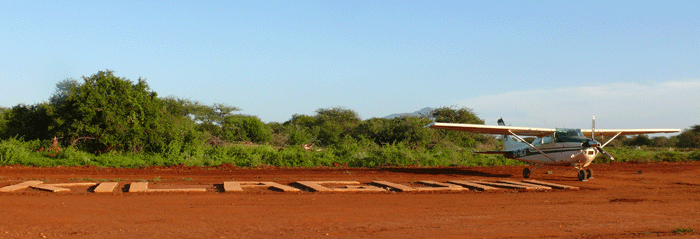
The count was completed after 4 full days of flying, and involved each of the eleven aircraft each day being allocated a ‘block’, a large piece of terrain, which was theirs to count. This the pilots achieved, with the help of both their front-seat and rear-seat observers, by flying parallel transects – usually a kilometre apart – up and down their allocated block, until they had counted all the elephants, other mammals and points of interest in their area. This took an average of ten hours per day per aircraft – then it was back to base, and time to upload all the collected data from each team’s GPS and data sheets into the main GIS computer, not forgetting the mandatory debrief in the bar every evening…
Off for another 10-hour day of counting...

And at the end of the week, not only had the team demonstrated that Kenya as a whole is not in “melt-down”, but also revealed that the number of elephants in the Tsavo Ecosystem has increased by 4% in the last 3 years. The population now stands at 11,696. This is just over a third of Kenya’s total elephant population, which stands at approximately 30,000, and indicates that Kenya’s sustained efforts to protect her elephants, alongside the international trade restrictions on ivory, are bearing fruit and setting an example to the wider world.
Team photo on the final day...
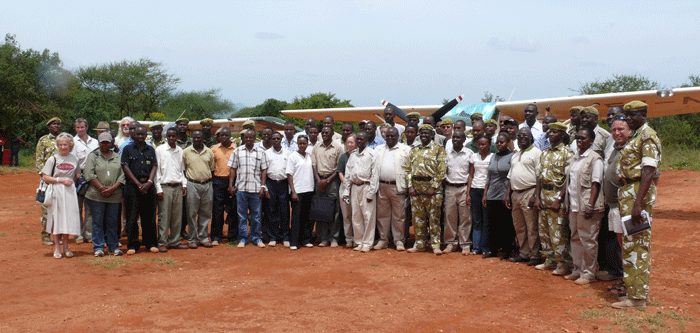
And of course, the benefits of the elephant count go way beyond just providing an elephant census and adhering to Kenya’s international obligations under MIKE and CITES (see previous post).
There are multiple spin-off benefits from an operation like this: it is an important factor in maintaining overall security of the National Parks and their surrounding areas, giving blanket air coverage for a week, and really being able to ascertain the situation with regards to incursions into the Parks, overall animal numbers, signs of human activity, poaching, and so forth.
Secondly, it provides an important demonstration of Kenya’s tourism potential – it’s not many (if any) countries in Africa, which can boast +/-12,000 elephants in one ecosystem.
Thirdly, it provides valuable scientific information with which protected area management plans can be drawn up, taking into account all the different factors recorded from the air.
Finally, it was heartening to see such a strong media presence at the count, with the main Kenyan TV channels and newspapers well represented and taking a real interest in the issues. The positive publicity gained can not only help boost local tourism (important to keep the economy buoyant in the low season for international tourists) and show a positive aspect of Kenya which many people oversees are not seeing at present due to the recent troubles in other parts of the country, but also to educate their fellow Kenyans about their own National Parks and the wealth of wildlife which is not only an important revenue earner through tourism, but is a unique part of their national heritage.
A herd of zebra cross the runway
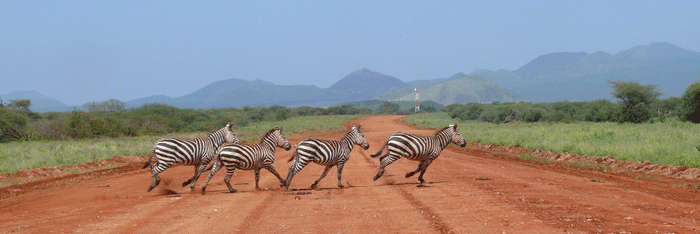
On the downside, it seems that a lot of the smaller game is disappearing from the Tsavo region, illegally hunted for ‘bushmeat’. ‘Bushmeat’ poaching is possibly the gravest threat to wildlife in Africa today, and containing it is one of the greatest challenges faced by wildlife authorities across the continent (and indeed internationally). It is obtained by illegally killing wild animals, often by cruel and inhumane methods. The meat is then transported to urban centers and sold in the markets, disguised as ordinary beef or goat (most people don’t even know they are buying ‘bushmeat’). It is also illegally exported in ever growing quantities to Europe and the US. Not only is this trade destroying one of Africa’s richest natural resources - its tourist-attracting wildlife - but it poses health risks to all who handle it and eat it. Recently, for example, it was proven that the deadly Ebola virus in Uganda initially spread to humans through the handling of dead monkeys. One method employed to kill wild animals is the setting of wire snares along well-used pathways, or around waterholes. Many of these snare lines could be seen from the air. For more information about the scourge of bushmeat poaching, you can visit the Bushmeat Crisis Taskforce website.
Despite this sad trend here (as in so much of Africa), Tsavo nonetheless remains one of the many natural jewels in Kenya’s crown. Tsavo East, with its vast size and true spirit of the wilderness is of course special to me, having been my childhood home, and Tsavo West – well, suffice to say, it is perhaps the most scenically stunning of all Kenya’s National Parks, with its dramatic lava cones and sweeping plains watched over by the looming bulk of Mt Kilimanjaro (Africa’s highest mountain just over the border in Tanzania), and its crystal clear Mzima Springs, feeding the whole of Mombasa, Kenya’s second city, with clean water from the impossibly beautiful Chuylu Hills…and game there was aplenty too in the areas I visited during the week – from elephants (stand up and be counted, you behemoths!) to giraffe, dik dik, impala, zebra (galloping across the runway in the wake of serial landings), the ever elegant kudu, herds of hulking eland, Africa’s largest antelopes, and of course, the famous hippos and crocodiles of Mzima Springs.
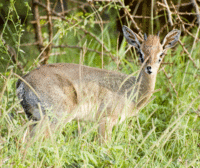
Dikdik in Tsavo West (look at that twitching nose!)
click any image to enlarge
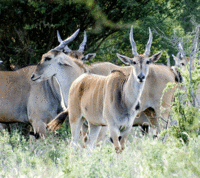
A lovely herd of Eland, Africa's largest antelope, in Tsavo West
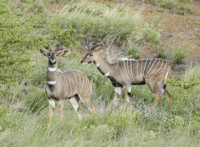
Lesser Kudu bulls in Tsavo West
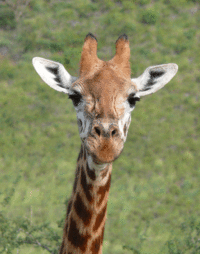
An inquisitive Giraffe in Tsavo West
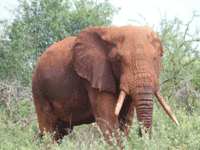
Bull elephant near the Kilaguni runway
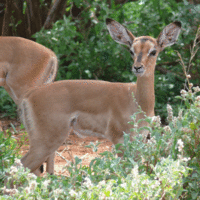
Impala fawn in Tsavo West
Mzima Springs remains a must-see place to visit, with its clear cool water bubbling out of the lava-laden soil, sustaining not only the human population that relies on the water piped from there 150 miles southwards to Mombasa, but also sustaining many a thirsty beast, and many an aquatic inhabitant - from the large pod of groaning hippos to the crocodiles and fish that you can watch from the underwater viewing tank – if you’re lucky you’ll see a hippo lumbering by at eye level too.
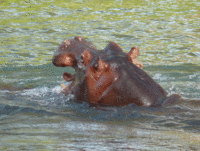
Mzima Springs Hippo
click any image to enlarge
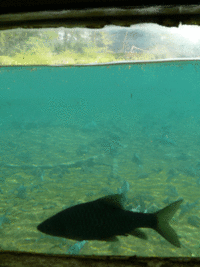
View from inside the submerged tank at Mzima Springs, in Tsavo West National Park

Eye-to-eye with a hippo at Mzima Springs
Tsavo West’s birdlife is plentiful and staggering in equal measure. Although the birds I saw this time are all familiar to me, they never fail to stun me with their extraordinary variety and vibrancy.
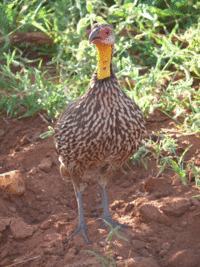
Yellow-necked Spurfowl
click any image to enlarge
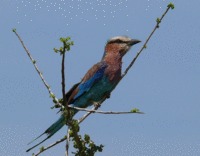
Lilac-breasted Roller
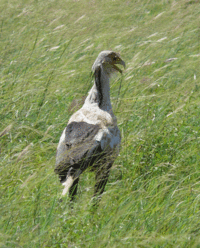
Secretary Bird in Tsavo West
Whose heart wouldn’t melt at these little fellows? These two vervet monkeys were engrossed in their grooming rituals (just look at the ecstasy on that little face), while a third monkey was content with a midday siesta.
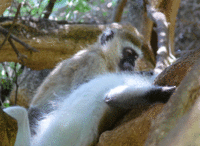
Vervet monkeys grooming rituals
click any image to enlarge
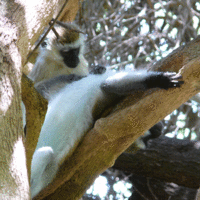
A thoroughly relaxing massage...
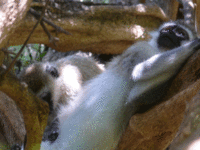
Look at that face!
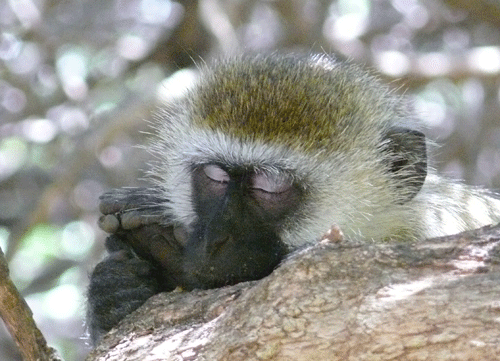
More in Pictures:
Tsavo Elephant Count 2008
Wild animals in Tsavo West and at Kulafumbi during January 2008...monkeys, elephants, antelope, hippos, crocodiles & more...
Birds of Kulafumbi and Tsavo West, photographed in January 2008...
Views of Mzima Springs in Tsavo West National Park...






Reader Comments (2)
Thanks for your encouraging comment on my blog. We are X-South Africans (I last lived there in the 80s). We go back everynow and then. Last time we went to Kruger and I feel in love the opportunity to view such great wild life. Find living in Africa a bit risky - but wow what an amazing opportunity you have to have wildlife in your 'back garden'. Treasure it.
Hi and thanks for stopping by. I can imagine that at times you must miss Africa - it can get its teeth into you! Although I hear New Zealand is an equally awe-inspiring place - it's definitely on our List of Countries to Visit One of These Days...
In my opinion, in life you always have to weigh up the positive things against the negative: if the negatives start to outweigh the positives, you have to make changes. If the positives outweigh the negatives, savour it!
Yes, there are many things which make life in Africa unpredictable and often difficult, but as we have this incredible opportunity to live in such a unique place, and have the chance to work here too, to help conserve all the things we love about the wilderness, we've decided this is where we want to be. My father tells the story of how, as a nineteen-year-old back in the fifties, when he decided to move up to Kenya from what was then Rhodesia, everyone said to him, "What do you want to do that for? East Africa has no future." And yet, he has had the most incredible life here, and contributed much to conservation in this country too - that's not to say there have not been some deep low points along the way, but overall, it has been an amazing ride. So, in the same spirit, my husband Ian and I have decided we too want to stay here. In the end, though the price is sometimes high in all sorts of different ways, for us it's home in the way that no other place is...